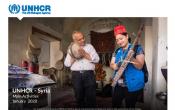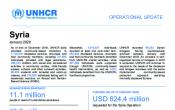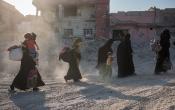Syrian Arab Republic
Operation: Syrian Arab Republic
Location
{"longitude":39,"latitude":35,"zoom_level":0,"iso_codes":"'SYR'"}
By clicking on the icons on the map, additional information is displayed.
The boundaries and names shown and the designations used on this map do not imply official endorsement or acceptance by the United Nations.
Key Figures
| 2019 year-end results | |
| 1.8 million | people were assisted with core relied items |
| 1.7 million | people benefitted from protection activities |
| 520,900 | people were supported with emergency and long-term shelter assistance |
| 427,600 | people accessed health care services |
| 311,700 | IDPs and returnees received counselling, information and legal aid through a network of more than 200 lawyers and 100 outreach volunteers |
| 101,200 | children were enrolled in accelerated education programmes |
| 93,500 | people with specific needs received psychosocial support |
| 17,600 | individuals were assisted with livelihood support |
| 2020 planning figures | |
| 750,000 | IDPs and refugee and IDP returnees will receive legal assistance |
| 550,000 | internally displaced and returning refugee and IDP families will have access to core relief items and winterization support |
| 80,000 | emergency shelters will be given to refugees and IDPs |
| 31,030 | long-term shelters will be provided to returnees |
| 7,600 | refugee and asylum-seeker households will receive cash grants |
Latest Updates and Related Links
People of Concern
5%
Increase in
2019
2019
| 2019 | 6,938,584 |
| 2018 | 6,600,217 |
| 2017 | 7,033,119 |

[["Refugees",16213],["Asylum-seekers",12069],["IDPs",6146994],["Returned IDPs",477360],["Returned refugees",94977],["Stateless",160000],["Others of concern",30971]]
Loading ...
Syrian Arab Republic
< Back
2019
{"categories":[2015,2016,2017,2018,2019,2020],"budget":[366.77411747,315.69039415,497.600068126,612.18900001,624.38269265,586.27371213],"expenditure":[173.76697349,137.49994288,159.72845298000001,186.69789025,176.13223937,null]}
{"categories":[2015,2016,2017,2018,2019,2020],"p1":[56.81599041,52.75013228,47.39999955,47.246065789999996,46.968149090000004,47.91403503],"p2":[0.17973042,0.1946423,0.21116958,0.19864073000000002,0.198641,0.19864019],"p3":[null,null,146,259.2,259.38285378,317.83304869],"p4":[309.77839664,262.74561957,303.988898996,305.54429349000003,317.83304877999996,220.32798822]}
{"categories":[2015,2016,2017,2018,2019,2020],"p1":[23.272340829999997,23.57270191,16.49820621,14.802303779999999,13.57418511,null],"p2":[0.12660126,0.10932031,0.007318,0.00788707,0.027757990000000003,null],"p3":[null,null,4.841297559999999,29.36963591,17.18097997,null],"p4":[150.3680314,113.81792066,138.38163121,142.51806349,145.3493163,null]}
Loading ...
CHOOSE A YEAR
- 2014
- 2015
- 2016
- 2017
- 2018
- 2019
- 2020
Operational context
In the ninth year of the crisis, humanitarian needs in the Syrian Arab Republic (Syria) remained staggering in terms of scale, severity and complexity, with protection risks persisting in a number of areas. The United Nations estimated that over 11 million people were in need of humanitarian assistance, including some 6.1 million internally displaced people. Some 4.65 million people were in acute need due to a convergence of vulnerabilities resulting from displacement, exposure to hostilities and limited access to basic goods and services, while an additional 1.1 million people in need were in hard to reach locations.There was a relative increase in the level and pace of IDP and refugee returns in 2019, with UNHCR having verified over 95,000 refugee returns to Syria - actual figures were likely to be higher. Since 2016, a total of 230,000 refugee returns has been verified by UNHCR. Added to this was an estimated 494,000 spontaneous IDP returns in 2019 (according to OCHA). With people returning despite the challenging circumstances, UNHCR’s operational focus shifted from emergency response to durable solutions. The operation aimed to provide initial support to returnees and vulnerable people through an area-based approach. This included immediate shelter repair, legal aid and support for documentation, community-based protection, primary health care, livelihoods and education. Support to IDPs and returnees required wider and more predictable humanitarian space for all actors.
Key challenges in 2019 included shrinking humanitarian space, the conditions of people living in overcrowded IDP sites, particularly in the north-west and north-east of the country, as well as the needs of host communities who shared resources with the displaced.
Population trends
In 2019, some 11 million people across the country were in need of humanitarian and protection assistance, with 6.1 million people internally displaced. As fighting continued in some areas, an estimated 1.8 million people moved across Syria in 2019, many multiple times. Meanwhile, by the end of 2019, there were around 28,300 refugees and asylum-seekers registered with UNHCR in Syria.Achievements
- As a result of UNHCR advocacy, the residency permit requirement for refugees and asylum-seekers was waived and UNHCR identification was accepted in order to register births and civil events instead of applying to the court. Birth registration for refugee and asylum-seeker children increased in 2019 to reach 275 children (66% of new births, compared to 63% in 2018).
- The Office also advocated for facilitated procedures to overcome challenges encountered by Syrian citizens in accessing civil documentation. Together with its legal partners, UNHCR provided technical support to restore the capacity of civil affairs offices to issue civil documents. Over 11,000 children benefited from birth registration through legal support, and 121,400 children benefitted from birth registration through technical support.
Unmet needs
- The operation was funded at 30% by the end of 2019.
- UNHCR experienced significant limitations in maintaining regular humanitarian access to identify protection needs and deliver quality protection services across the country. Remote areas with reported returns such as Idleb, Raqqa and Deir-ez-Zour governorates were particularly affected. UNHCR was unable to expand its outreach network by opening 28 new community centres, as planned, leaving nearly 600,000 IDPs and returnees without much needed protection services, and communities without awareness raising and other activities on child protection and sexual and gender-based violence. Some assistance activities were unable to be carried out, leaving 2.6 million IDPs and returnees without core relief items and seasonal kits, 452,700 IDPs, returnees and refugees without shelter assistance, and 971,000 returnees and host community members without improved water supply. The formal registration of the camp-based population in Al-Hassakeh governorate, north-east Syria, was not fully achieved by end of 2019 due to operational constraints and the new emergency context in north-east Syria.
Working environment
The humanitarian needs in the Arab Republic of Syria (Syria) remain of a staggering scale, severity and complexity, with significant protection risks persisting in a number of areas. According to the 2018 HRP, a total of 12.8 million people are in need of humanitarian assistance, including 6.2 million people who are internally displaced.Large number of IDPs are starting to return as the Government of Syria continues to gain control of large parts of the country. In parallel, a new trend of self-organized returns of refugees from neighboring countries is emerging. From January to August 2018, UNHCR had confirmed 23,000 self-organized returns, bringing the number of self-organized refugee returns to Syria since 2015 to 100,000. UNHCR is not able to monitor and confirm every spontaneous return to Syria as it is not facilitating these moves; thus the actual figure of returns is likely much higher. In addition, an estimated 750,000 IDPs have returned home to areas of relative stability in Syria. UNHCR’s position recognizes that refugees have the fundamental human right to return in safety and dignity to their country of origin at a time of their own choosing. UNHCR is engaging with the Government of Syria and providing legal support with civil documentation, as part of humanitarian assistance given to returnees.
UNHCR’s planning for 2019 is based on the assumption that localized hostilities will continue resulting in new displacement, while spontaneous returns of IDPs and refugees are anticipated to increase to areas that have become accessible and relatively stable.
In the context of the Whole of Syria approach, UNHCR continues to play a key coordination role as a lead Agency for the Protection/Community Services, Shelter and Non-Food items sectors.
Key Priorities
In 2019, UNHCR will focus on:- Responding to the immediate and urgent humanitarian needs of IDP, refugee returnees and host communities; reinforcing returnee tracking and monitoring; and facilitating the repair of critical social and basic services in return areas.
- Reinforcing operational capacity and responding to the protection and assistance needs of IDPs and host communities under the regular programme.
- Engaging in provision of emergency and humanitarian assistance to persons of concern in its capacity as the lead in responding to internal displacement in the life-saving sectors of Protection/Community Services, Shelter, and Non-Food Items.
- Providing protection and assistance to refugees and asylum-seekers in Syria.

















